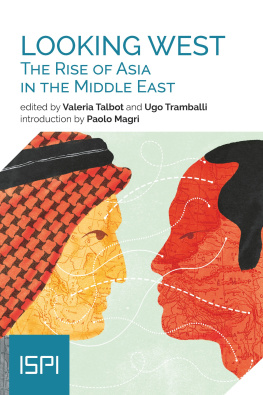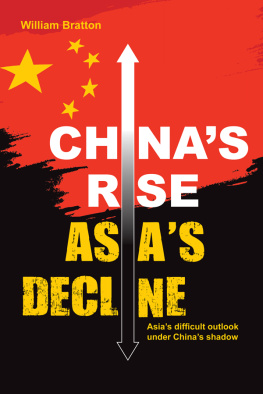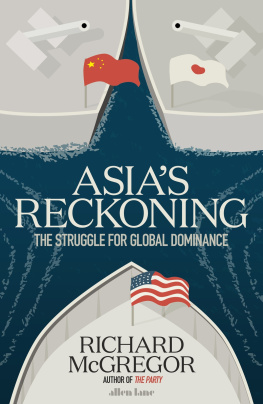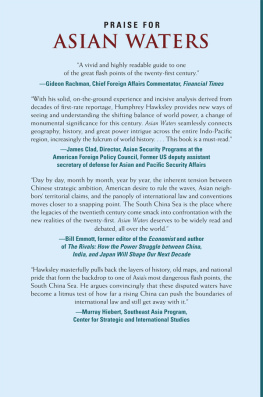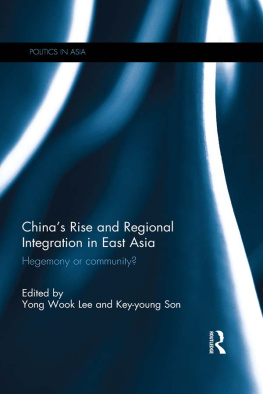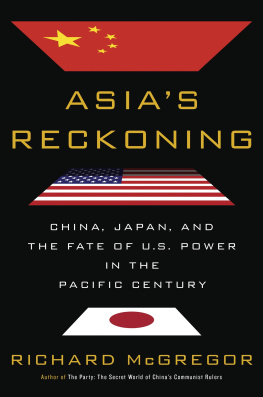THE END OF THE ASIAN CENTURY
THE END OF THE ASIAN CENTURY
War, Stagnation, and the Risks to the Worlds Most Dynamic Region
Michael R. Auslin

Published with assistance from the Kingsley Trust Association Publication Fund established by the Scroll and Key Society of Yale College.
Copyright 2017 by Michael R. Auslin.
All rights reserved.
This book may not be reproduced, in whole or in part, including illustrations, in any form (beyond that copying permitted by Sections 107 and 108 of the U.S. Copyright Law and except by reviewers for the public press), without written permission from the publishers.
Yale University Press books may be purchased in quantity for educational, business, or promotional use. For information, please e-mail sales.press@yale.edu (U.S. office) or sales@yaleup.co.uk (U.K. office).
Set in Galliard type by Westchester Publishing Services
Printed in the United States of America
Library of Congress Control Number: 2016942335
ISBN 978-0-300-21222-8 (hardcover : alk. paper)
A catalogue record for this book is available from the British Library.
This paper meets the requirements of ANSI/NISO Z39.481992
(Permanence of Paper).
10 9 8 7 6 5 4 3 2 1
IN MEMORY OF MY FATHER,
DONALD E. AUSLIN (19332016)
PREFACE: THE ASIA NOBODY SEES
I am hunched over, almost on my hands and knees, nearly 250 feet below ground. Behind me is close to a mile of tunnel, hewn through solid rock. In front of me is a steel door set into a concrete barricade. Through its tiny window I can see another barricade and steel door, maybe another one hundred feet ahead. Beyond that lies North Korea.
I have crawled into one of the dozens of tunnels of aggression dug by the Pyongyang regime into South Korean territory. Discovered in 1978, it lies only twenty-seven miles from Seoul and was designed to bring waves of North Korean saboteurs and special forces under the heavily defended border to wreak havoc in case of war. It is the only tunnel open to the public, and the tour buses that bring visitors to this no-mans-land pass by hills that still contain hundreds of land mines aimed at stopping an invasion from the North.
Yet as much as Tunnel Number Three is a reminder that the Korean border, the ironically named Demilitarized Zone, remains one of the most dangerous spots on earth, it also is a metaphor for all of Asia. While dynamic and peaceful on the surface, the continent is riddled with unseen threats, from economic stagnation to political unrest and growing military tensions. These risks also threaten the rest of the world, thanks to the extraordinary economic, political, and military growth of Asia over the past decades.
To put it starkly, what we are seeing today may be the beginning of the end of the Asian Century. For decades, prominent and knowledgeable All those predictions now are themselves at risk.
I did not travel to Asia looking for trouble. Just the contrary. After nearly a quarter-century studying and dealing with Asia, I initially planned on writing a book on how Americas future would be tied to a resurgent Indo-Pacific, a variant of what then secretary of state Hillary Clinton called Americas Pacific Century. To my surprise (and initial resistance), the more I traveled around the region, starting around 2010, the more I became aware of the risks we in the West were ignoring.
Such a view remains controversial. Only in recent months have the popular press and casual observers begun to worry about growing risk, from Chinas stock market collapse to the danger of armed conflict in the South China Sea. But in a world where headlines continue to focus on the bloody spread of the Islamic State or on Russias invasion of Ukraine and intervention in the Syrian civil war, only cursory attention is being paid to Asias dangers.
As this is being written, Chinas economy has dramatically slowed, North Korea claims that it has a hydrogen bomb and is widely believed to be able to put nuclear weapons on top of ballistic missiles, Thailands military has launched its second coup in a decade, and Chinese newspapers warn that war with America is inevitable if Washington does not back down from opposing Chinas territorial claims in the South China Sea. These are just some of the more visible dangers that perturb the Indo-Pacific. We are on the cusp of a change in the global zeitgeist, from celebrating a strong and growing Asia to worrying about a weak and dangerous Asia. For all its undeniable successes and strengths, the broader Indo-Pacific region faces significant, potentially insurmountable challenges.
The rest of us should worry because none of these problems threaten only Asia. Whether one cares about the Indo-Pacific or not, it is half of our world. Today, one out of every three persons on earth is of Chinese or Indian descent, and the countries of the Indo-Pacific already account and they are central to everything from weaving textiles to crafting the most advanced electronic technology. The militaries of Asias countries have grown dramatically, and China, India, and North Korea are nuclear powers. Democracies jostle with authoritarian states as neighbors in the worlds most dynamic region.
But the globalization that we continue to celebrate has its dark side as well. If an economic or security crisis erupted in Asia, it would reverberate around our increasingly interconnected world. Those risks are festering, some visible, others still hidden. The number one priority for the countries of the Asia-Pacific, and the rest of the world, over the coming decade is managing and mitigating the risks that threaten the Asian Century.
Yet despite the threat to the larger global system from Asias risks, no book or article has yet offered a comprehensive view of the various major dangers Asia faces, or how they are intertwined. Many predictions are thus misleadingly rosy, such as the assumption that China and Japan will not go to war over disputed island territory because their economic ties are too deep, or that North Korea will not launch a nuclear missile at Seoul or Tokyo because to do so would be a suicidal act. Similarly, investors and manufacturers simply assume that if one Asian country falters, another will take its place, as China replaced Japan in the 1990s.
Little attention has been paid to understanding the broader economic slowdown that could cause global growth to grind to a halt. Or how the combination of nationalism and miscalculation could result in armed conflict over territorial disputes. A succession of crises could in turn lead to political upheaval and revolution, plunging some societies into civil war and crushing democracy in others. For all these reasons, getting ahead of the risk curve in Asia is necessary if prosperity, freedom, and stability are to be protected and nurtured. That is what is at stake if the Asian Century ends.
No book can cover everything happening in this vibrant region, nor is this one meant to repeat the latest headlines. Instead, my goal is to explore the factors that threaten Asias future and put at risk what we have imagined as the Asian Century. Some readers will be disappointed that I do not discuss certain countries or that I mention them only in passing, even though they are fascinating and important. For example, Mongolia is recapturing its native traditions and simultaneously globalizing its economy and playing a larger role in regional security, but I hardly cover it. The countries of the Mekong River region get far less attention here than their neighbors, whom I see as the more important drivers of risk. Russia, too, deserves more than the occasional remark. I have excluded these nations from this book because the numerous Asian business leaders, officials, and experts with whom I talked were focused on other matters.


